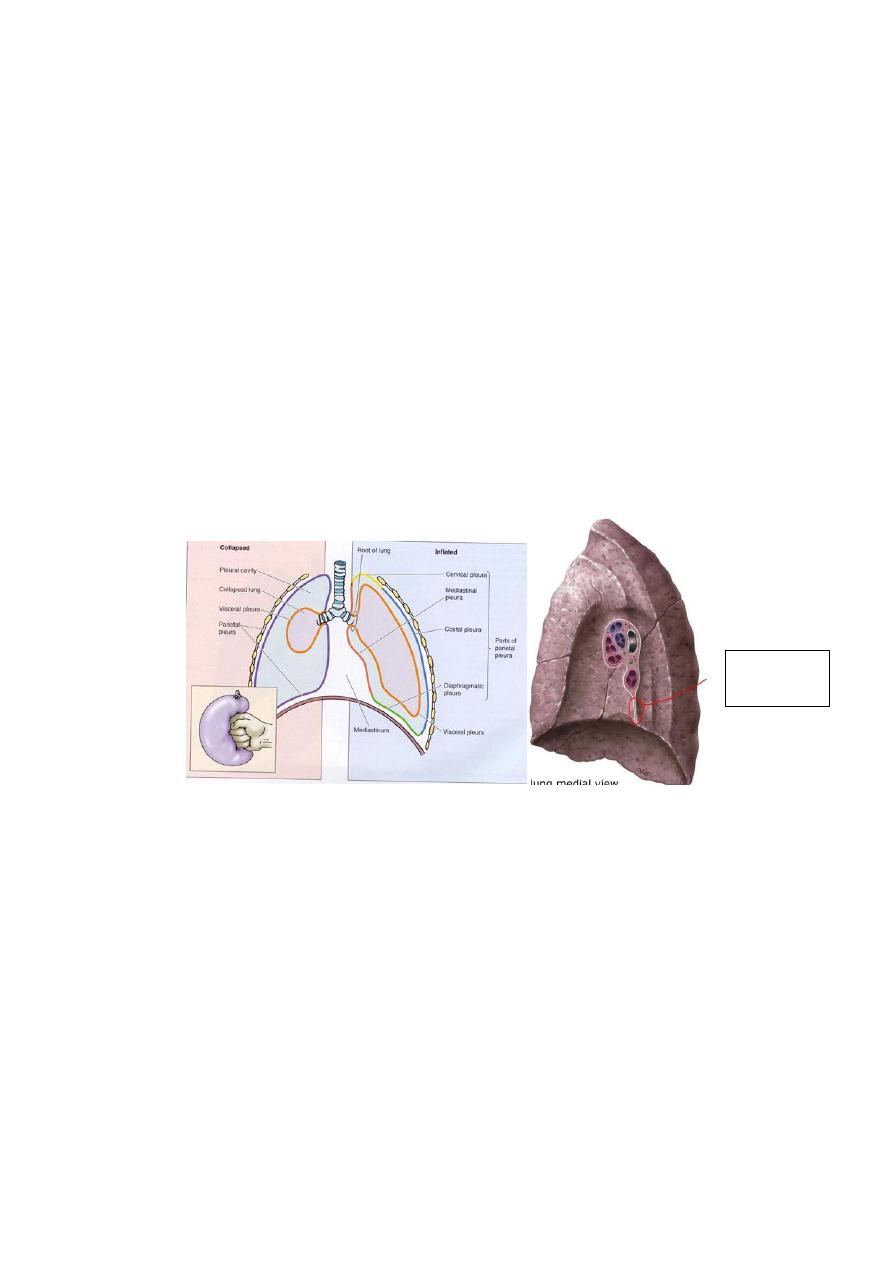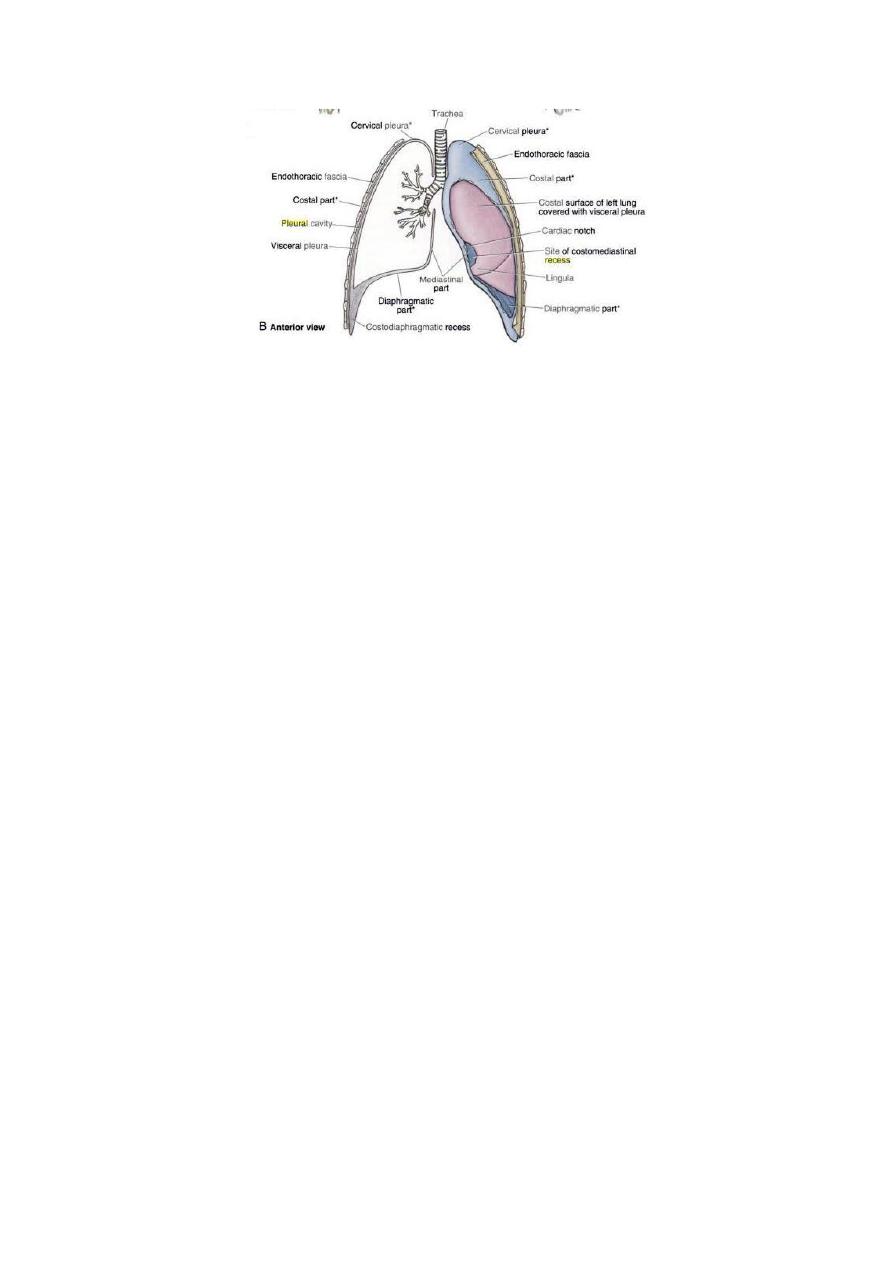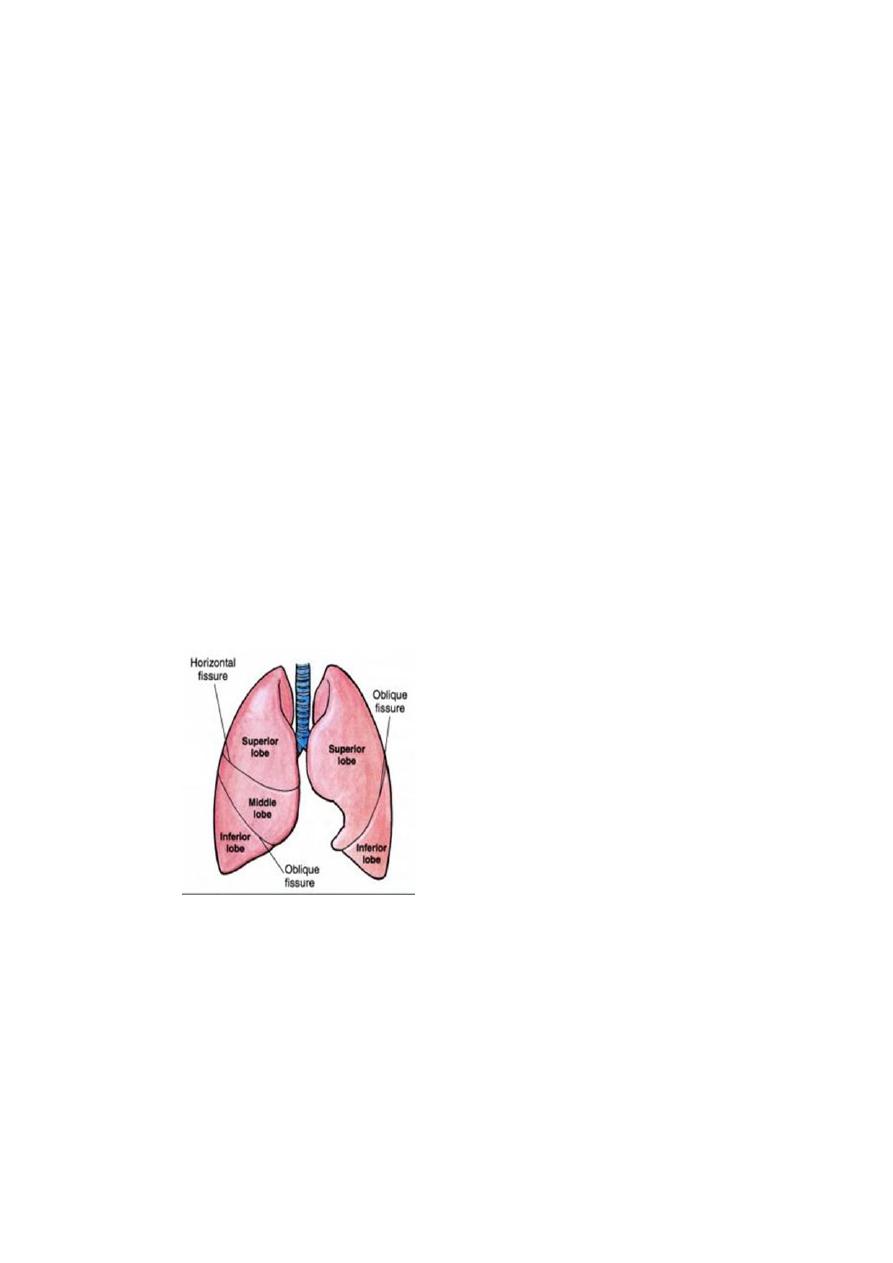
Lecture 4
Thorax
د.رندعبداللطيف
Pleura
This is a closed serous sac, invaginated from the mediastinal side by the lung as
if a balloon is invaginated by a fist. It consists of 2 layers which become
continuous with each other around the lung hilum. The inner layer is in direct
contact with the lung is the visceral pleura which is adherent to the lung tissue&
it enters lung fissures.
The outer layer (parietal pleura) lines the thoracic wall so it is divided according
to its position into: costal, diaphragmatic, mediastinal & cervical pleura. The
two layers are separated from one another by a slitlike space (pleural cavity)
which normally contains a small amount of tissue fluid (pleural fluid) which
forms a thin film to reduce friction.
The two layers become continuous with one another by means of a cuff of
pleura that surrounds the structures at the hilum of lung. To allow movement of
the pulmonary vessels and large bronchi during respiration, the pleural cuff
hangs down as a loose fold called the pulmonary ligament.
The cervical pleura extends up into the neck, lining the undersurface of the
suprapleural membrane. It reaches a level 1 to 1.5 inch (2.5 to 4 cm) above the
medial third of the clavicle.
The costal pleura lines the inner surfaces of the ribs, the costal cartilages, the
intercostal spaces, the sides of the vertebral bodies, and the back of the sternum.
The diaphragmatic pleura covers the thoracic surface of the diaphragm.
The mediastinal pleura covers and forms the lateral boundary of the
mediastinum.
Pulmonary
ligament

Lecture 4
Thorax
د.رندعبداللطيف
Nerve Supply of the Pleura
The nerve supply of the visceral pleura is by autonomic fibers from pulmonary
plexus, while the parietal layer is supplied by intercostal nerves for the costal
part, phrenic nerve for the mediastinal part & diaphragmatic part of parietal
pleura and the peripheral parts of diaphragmatic pleura by intercostal.
The Bronchi
The trachea bifurcates behind the arch of the aorta into the right and left
principal (primary or main) bronchi which divide giving rise to several
million terminal bronchioles that terminate in one or more respiratory
bronchioles. Each respiratory bronchiole divides into 2 to 11 alveolar ducts that
enter the alveolar sacs.
The right principal main bronchus is wider, shorter, and more vertical than
the left and is about 1 inch (2.5 cm) long. Before entering the hilum of the right
lung, the principal bronchus gives off the superior lobar bronchus or
eparterial bronchus. On entering the hilum, it divides into a middle and an
inferior lobar bronchus. The left principal (main) bronchus is narrower,
longer, and more horizontal than the right and is about 2 inch (5 cm) long. It
passes to the left below the arch of the aorta and in front of the esophagus. On
entering the hilum of the left lung, the principal bronchus divides into a
superior and an inferior lobar bronchus.
Blood supply of bronchial tree
Two left bronchial arteries arise from the descending thoracic aorta, while there
is only one Rt bronchial A. arising from the upper left bronchial A. or from
intercostal arteries.
Lymphatics of the bronchial tree: All drain to Bronchomediastinal lymph
trunks which drain on the Rt to the Rt lymph duct & on the Lt to the thoracic
duct.

Lecture 4
Thorax
د.رندعبداللطيف
Lung
During life, the lungs are soft, spongy and very elastic. In the child, they are
pink, but with age, they become dark and mottled because of the inhalation of
dust particles. The lung is conical in shape and has a blunt apex, which projects
upward into the neck for about 1 inch (2.5 cm) above the clavicle; a concave
base that sits on the diaphragm; a convex costal surface, which corresponds to
the concave chest wall; and a concave mediastinal surface, which is molded to
the pericardium and other mediastinal structures.
Right Lung
The right lung is slightly larger than the left and is divided by the oblique and
horizontal fissures into three lobes: the upper, middle, and lower lobes. The
oblique fissure runs from the inferior border upward and backward across the
medial and costal surfaces until it cuts the posterior border about 2.5 in. (6.25
cm) below the apex. The horizontal fissure runs horizontally across the costal
surface at the level of the 4th cc to meet the oblique fissure in the midaxillary
line. The middle lobe is thus a small triangular lobe bounded by the horizontal
and oblique fissures. Related to the root of right lung the arch of a zygos vein
above the lung root and the azygos vein behind the lung root
.
Left Lung
The left lung is divided by a similar oblique fissure into two lobes: the upper
and lower lobes. There is no horizontal fissure in the left lung. The root of left
lung is related to the arch of aorta above the lung root and descending thoracic
aorta behind the lung root.

Lecture 4
Thorax
د.رندعبداللطيف
Bronchopulmonary Segments
The bronchopulmonary segments are the anatomic, functional units of the lungs.
Each lobar (secondary) bronchus, which passes to a lobe of the lung, gives off
branches called segmental (tertiary) bronchi. Each segmental bronchus passes
to a structurally and functionally independent unit of a lung lobe called a
bronchopulmonary segment, which is surrounded by connective tissue. The
segmental bronchus is accompanied by a branch of the pulmonary artery, but
the tributaries of the pulmonary veins run in the connective tissue between
adjacent bronchopulmonary segments. Each segment has its own lymphatic
vessels and autonomic nerve supply.
On entering a bronchopulmonary segment, each segmental bronchus divides
repeatedly& become smaller, The smallest bronchi divide and give rise to
bronchioles, which are <1 mm in diameter & with no cartilage in their walls.
The bronchioles then divide and give rise to terminal bronchioles which show
delicate outpouchings from their walls named respiratory bronchiole. The
respiratory bronchioles end by branching into alveolar ducts, which lead into
tubular passages with numerous thin-walled sacs called alveolar sacs which
consist of several alveoli (sites of gaseous exchange).
The main bronchopulmonary
segments are as follows:
Right lung has the following
B-P segments:
Superior lobe: Apical,
posterior, anterior
Middle lobe: Lateral, medial
Inferior lobe: Superior
(apical), medial basal,
anterior basal, lateral basal,
posterior basal.
Left lung has the following B-P segments:
Superior lobe: Apical, posterior, anterior, superior lingular, inferior lingular.
Inferior lobe: Superior (apical), medial basal, anterior basal, lateral basal,
posterior basal.
The root of the lung is formed of structures that are entering or leaving the
lung. It is made up of the bronchi, pulmonary artery and veins, lymph vessels,
bronchial vessels, and nerves. The root is surrounded by a tubular sheath of

Lecture 4
Thorax
د.رندعبداللطيف
pleura, which joins the mediastinal parietal pleura to the visceral pleura
covering the lungs.
Blood Supply of the Lungs
Bronchial arteries, which are branches of the descending aorta. The bronchial
veins (which communicate with the pulmonary veins) drain into the azygos and
hemiazygos veins.
Note: The alveoli receive deoxygenated blood from the terminal branches of
the pulmonary arteries. The oxygenated blood leaving the alveolar capillaries
drains into the tributaries of the pulmonary veins, which follow the
intersegmental connective tissue septa to the lung root. Two pulmonary veins
leave each lung root to empty into the left atrium of the heart.
Lymph Drainage of the Lungs
1- The superficial (subpleural) plexus lies beneath the visceral pleura and
drains over the surface of the lung toward the hilum, where the lymph
vessels enter the bronchopulmonary nodes.
2- The deep plexus travels along the bronchi and pulmonary vessels passing
through pulmonary nodes located within the lung substance toward the
hilum of the lung, the lymph then enters the bronchopulmonary nodes in
the hilum of the lung. All the lymph from the lung leaves the hilum and
drains into the tracheobronchial nodes and then into the
bronchomediastinal lymph trunks.
Nerve Supply of the Lungs
Nerves supply are from the pulmonary plexuses( Anterior & posterior)
containing fibers from both sympathetic & parasympathetic .The sympathetic
causes bronchodilatation & vasoconstriction ,while the parasympathetic
components causes Bronchoconstriction & Vasodilatation in addition it
increases the glandular secretion.
Surface marking of pleurae:
The cervical part of parietal pleura (Dome of pleura) project through the inlet
of thorax to the root of the neck (just like the apex of the lung) and is being
separated from the structures at the root of the neck by suprapleural membrane
which intervenes between these structures & the dome of the pleura. It starts
from sternoclavicular joint to appoint about 1 inch (2.5 cm) above the junction
between the medial & intermediate thirds of the clavicle. The anterior border of
parietal pleura( on Right side ) extends anteriorly & down wards from the Right

Lecture 4
Thorax
د.رندعبداللطيف
sternoclavicular joint to the level of the sternal angle and then continues down
ward to the level of Xiphisternal joint.
While on the left side the anterior border descends downward too till the level
of the 4
th
costal cartilage, then deviates laterally along the lateral margin of the
sternum to reach the level of the cardiac notch. It then descends sharply to reach
the level of 6
th
costal cartilage.
The inferior border of the parietal pleura will passes downward and laterally
from Xiphisternal joint crossing the 8
th
Rib at the midclavicular line, the 10
th
Rib at midaxillary line & the 12
th
Rib adjacent to the vertebral column >the
posterior border of the parietal pleura extends from the back of the Dme of
pleura above to end just below the neck of the last rib where it meets the
terminal end of the line representing the anterior border of the pleura.
The lungs has the same surface markings as that of parietal pleura except that
the inferior border of the lung is 2 vertebral level of the pleura .Thus inferior
border of the lung crosses the 6
th
Rib at midclavicular line, the 8
th
rib at
midaxillary line & 10
th
Rib adjacent to the vertebral column.
The space between the inferior border of the lung & the parietal pleura
represents the COSTODIAPHRAGMATIC pleural recess which the lung is
going to occupy it completely only in deep inspiration as in cases of a cute
attacks of Asthma.
The Pleural recess are in fact a gap or small spaces forms due to reflection of
one part of parietal pleura against another part and normally these recesses are
not occupied by lung tissues and there are 3 recess :
1-Costodiaphragmatic due to reflection of costal against diaphragmatic parts of
the parietal pleura.
2-Costomediastinal due to reflection of costal against the mediastinal part of the
parietal pleura.
3-Mediastinodiaphragmatic forms due to reflection of the mediastinal against
the diaphragmatic part of parietal pleura (this recess is not important and is the
smallest one among the 3 recesses).
